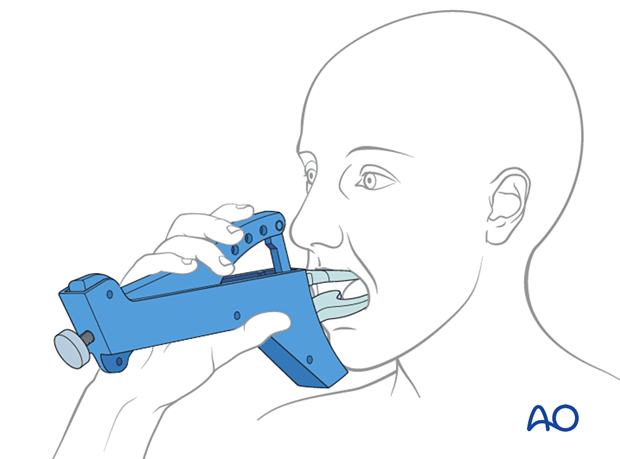ORIF, one load sharing plate
1. Principles
Champy's ideal line of osteosynthesis
For angle fractures, the ideal line of osteosynthesis is located along the upper border of the lateral surface of the mandible (A).
An alternative to this position is at the external oblique ridge (B).
The advantages of placement (A) are:
- no or minimal adaptation of the plate is required
- there is less risk of complications (plate exposure)
Al-Moraissi EA, Ellis E 3rd. What method for management of unilateral mandibular angle fractures has the lowest rate of postoperative complications? A systematic review and meta-analysis. J Oral Maxillofac Surg. 2014 Nov;72(11):2197-211.
Laverick S, Siddappa P, Wong H, Patel P, Jones DC. Intraoral external oblique ridge compared with transbuccal lateral cortical plate fixation for the treatment of fractures of the mandibular angle: prospective randomised trial. Br J Oral Maxillofac Surg. 2012 Jun;50(4):344-9.
Sugar AW, Gibbons AJ, Patton DW, Silvester KC, Hodder SC, Gray M, Snooks H, Watkins A. A randomised controlled trial comparing fixation of mandibular angle fractures with a single miniplate placed either transbuccally and intra-orally, or intra-orally alone. Int J Oral Maxillofac Surg. 2009 Mar;38(3):241-5.
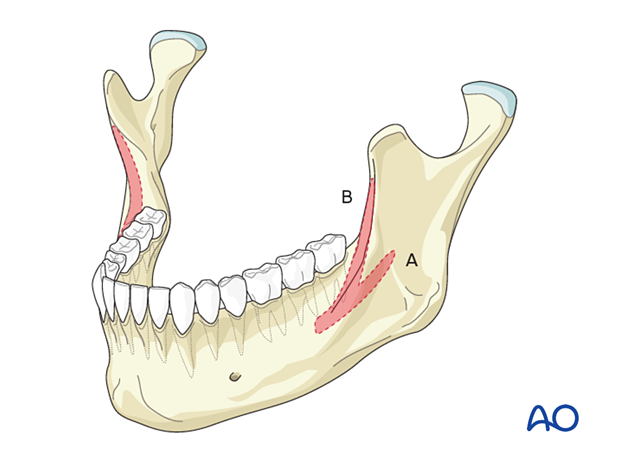
Special considerations
The following special considerations may need to be taken into account:
Additional reading
The below additional reading may be useful:
2. Patient preparation
This procedure is typically performed with the patient placed in a supine position.
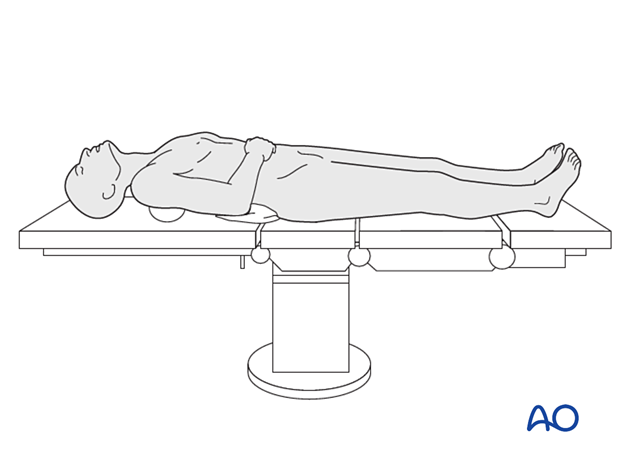
3. Approach
For this procedure, the transoral approach to the angle is typically used.
Incision A (vestibular incision) can be used when there is no third molar present, or when there is an unerupted third molar that may or may not require removal.
Incision B is used when there is an erupted third molar that must be removed during surgery. Incision B allows the development of a buccal mucoperiosteal flap that can be advanced to cover the extraction socket.
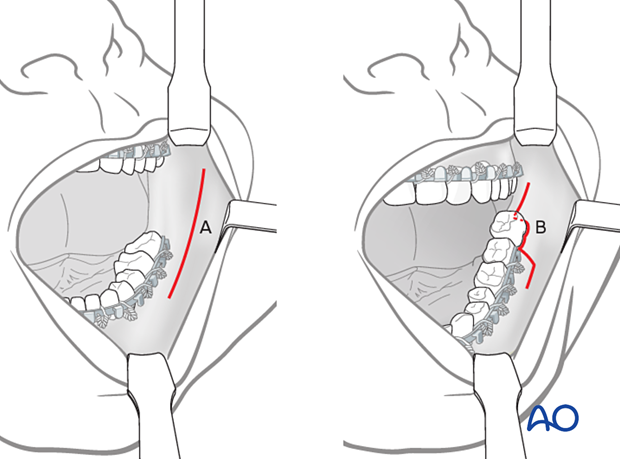
4. Choice of implant
The surgeon must choose whether to use a 4 or 6-hole miniplate (load sharing plate).
Very often, a 4-hole titanium miniplate can be adapted quite nicely to this area. However, if a third molar is present or recently extracted, the bone in this area may be absent.
The surgeon may choose to use a longer 6-hole plate to span the defect. There may be empty screw holes over the region where the bone is missing.
The surgeon has several options when choosing a plate for this region. The minimum size would be a mandible 2.0 miniplate. However, some surgeons prefer a more rigid plate, such as the 2.0 locking plate, which comes in incremental profiles. The small profile and medium profile plates may be used for either plate position.
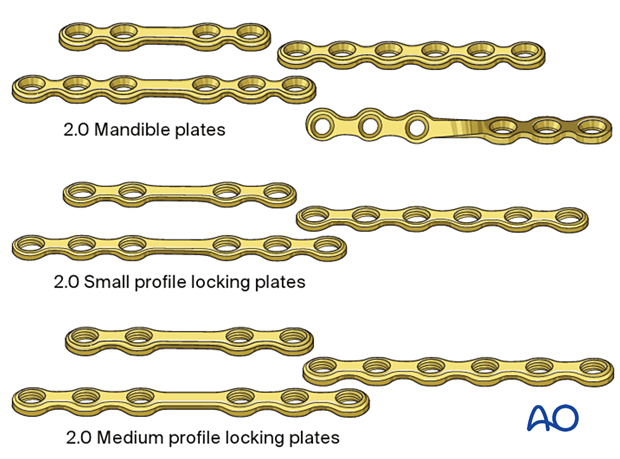
5. Reduction
Open reduction and stable internal fixation in the dentate patient begin with fixation of the occlusion. Before placing the patient into MMF, the fracture should be exposed, and any extractions deemed necessary performed. The fracture should be exposed and reduced before placing the patient into occlusion and securing the MMF.
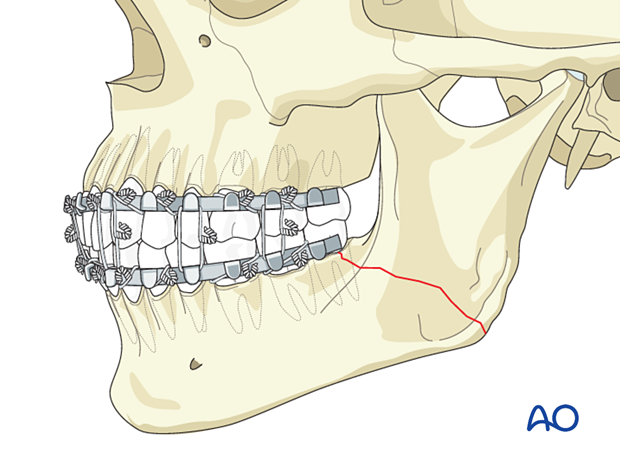
6. Plate fixation along the upper border of the lateral surface of the mandible (Option A)
Plate contouring
When needed, the plate is contoured to fit the lateral surface of the mandible.
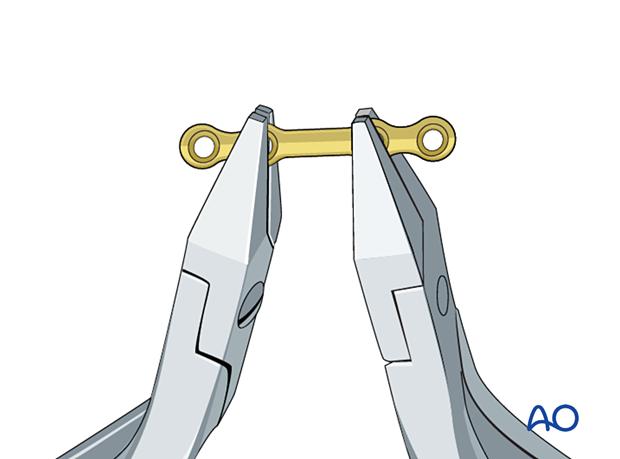
Apply the plate to the bone spanning the fracture.
The plate should be placed to avoid potential screw penetration into the alveolar canal.
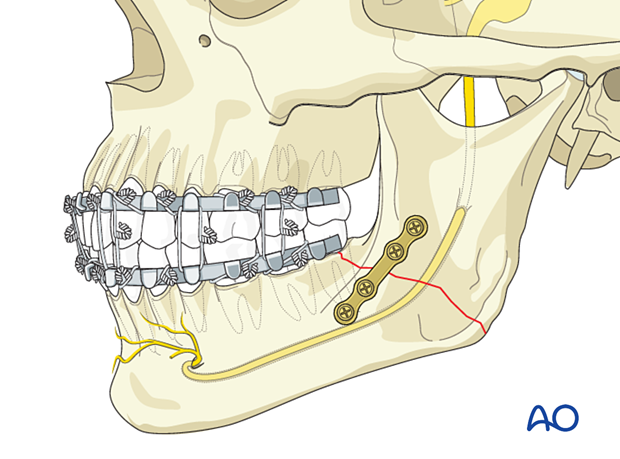
Transbuccal trocar instrumentation
All screws will need to be instrumented using transbuccal trocar instrumentation.
Alternatively, an angulated screwdriver may be used.
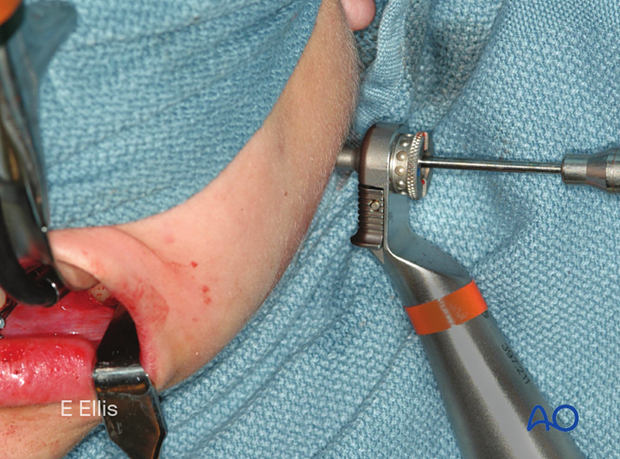
Fixation
Application of the first screwApply the screw just posterior to the fracture first. Use a 1.5 mm drill to drill a monocortical hole.
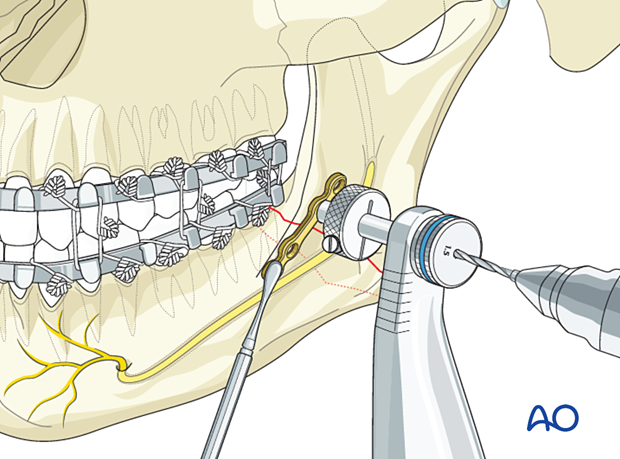
Insert a 6 mm screw and without tightening it completely, allowing the anterior portion of the plate to be rotated upwards or downwards as necessary to avoid the risk of screw penetration into the alveolar canal.
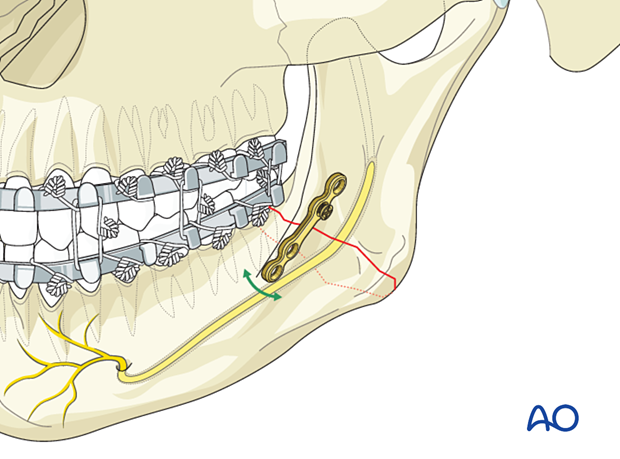
Drag the plate/ramus anteriorly with a point of a periosteal elevator and move it up or down until it is seated flush with the buccal cortex. Drill the hole just anterior to the fracture.
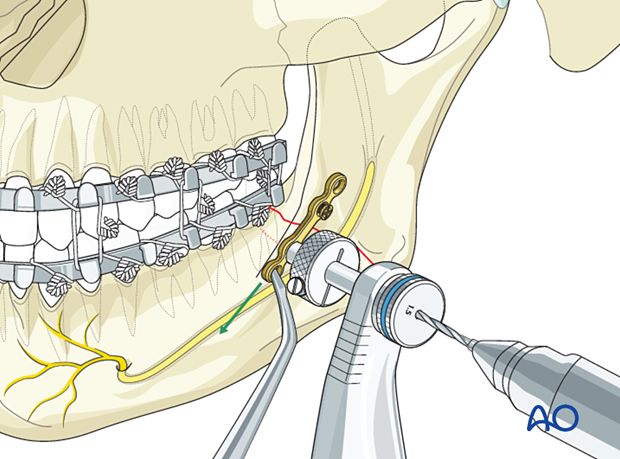
Insert the second screw and tighten it.
Then, tighten the first screw.
Confirm fracture reduction.
In case reduction is lost during screw tightening, the plate will need to be re-contoured to ensure passive fit to the lateral mandibular surface.
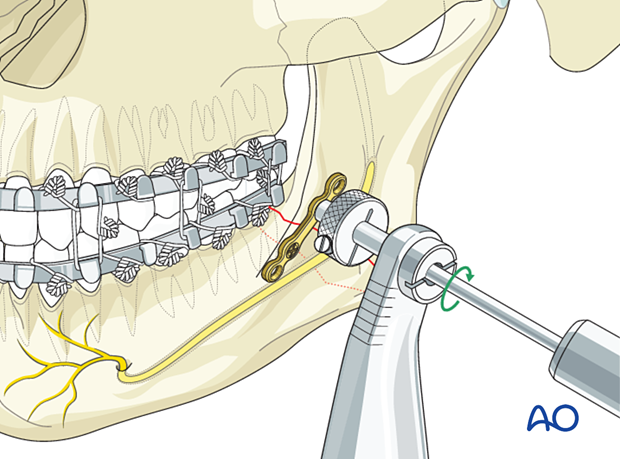
Drill a hole through the most anterior plate hole. Insert and tighten the screw.
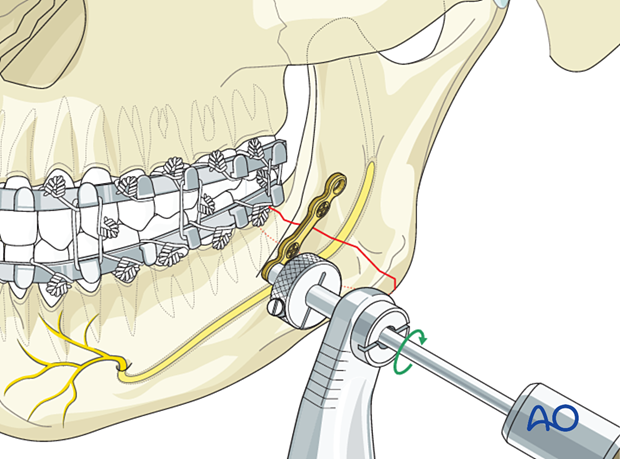
The final screw is inserted and tightened.
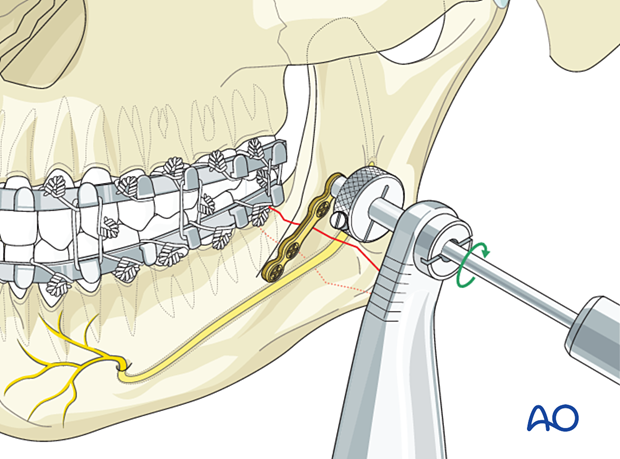
This clinical picture shows the final fixation.
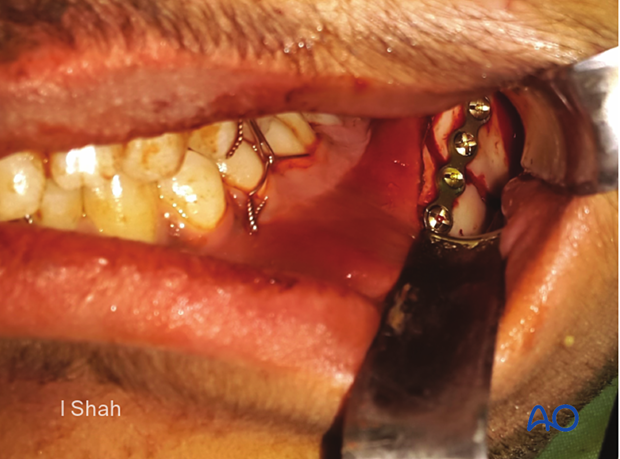
Final check
Release the MMF and check the occlusion for accuracy before proceeding with closure.
X-ray shows the completed osteosynthesis.
Note that the patient is not in MMF in the postoperative phase.
If arch bars are used, they are left in place for around two weeks and are only removed if no postoperative complications arise.
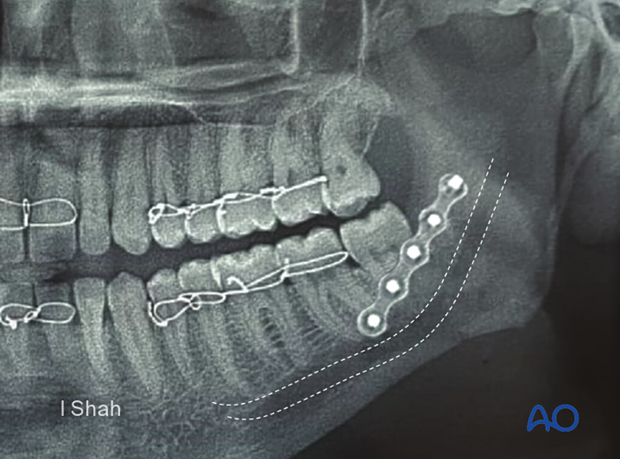
7. Plate fixation along the external oblique ridge (Option B)
Teaching videos
Application of a miniplate to the external oblique ridge
$name
Application of a locking plate to the external oblique ridge
Plate adaption
Twist the plate approximately 90° to facilitate adaptation to the superior mandibular border in the angle region. Pre-twisted mandible plates 2.0 are available at 70°.
Alternatively, pre-bent plates can be used and adjusted to the local anatomy.
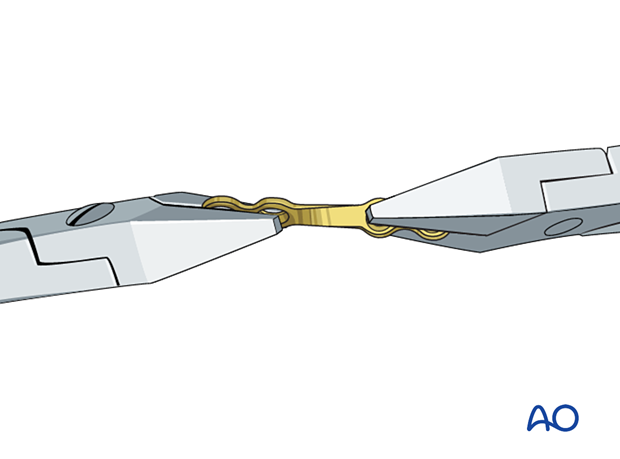
Apply the plate to the bone spanning the fracture. Note that the two posterior holes of the plate are located medial to the external oblique ridge, and the two anterior holes are placed along the lateral cortex.
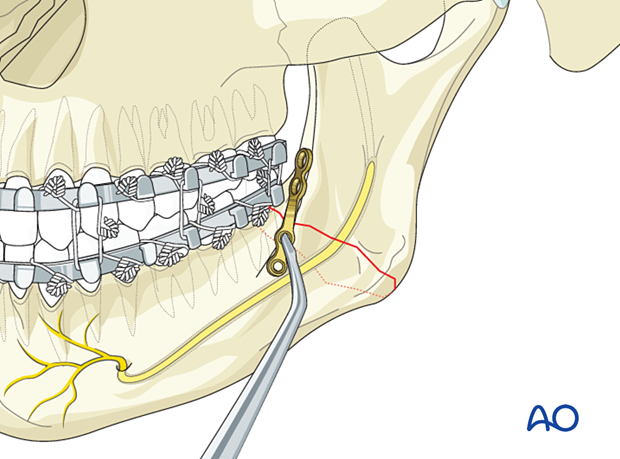
Fixation
Application of the first screwApply the screw just posterior to the fracture first. Use a 1.5 mm drill to make a monocortical hole.
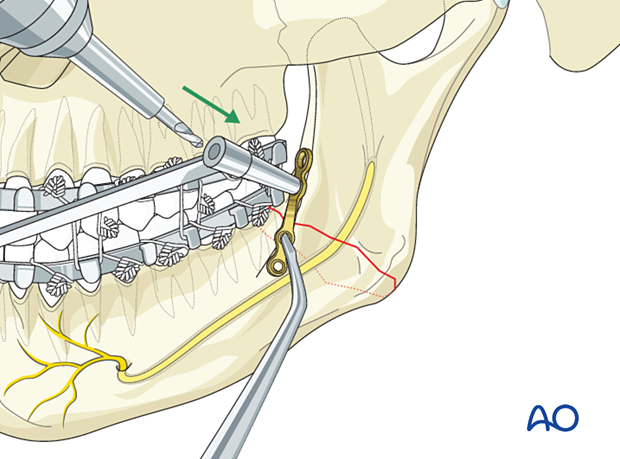
Insert a 6 mm screw without tightening it completely, allowing the anterior portion of the plate to be rotated upwards or downwards as necessary to better adapt it to the bone.
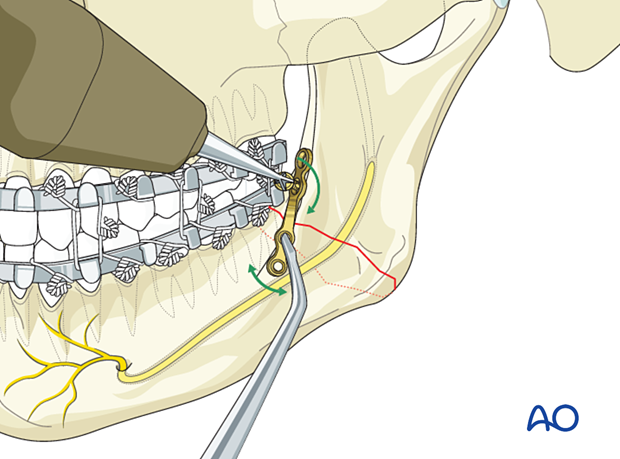
Drag the plate/ramus anteriorly with a point of a periosteal elevator and move it up or down until it is seated flush with the buccal cortex. Drill the hole just anterior to the fracture.
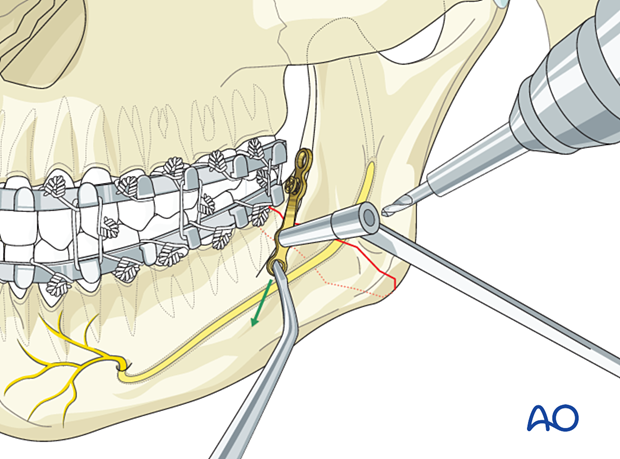
Insert the second screw and tighten it.
Then, tighten the first screw.
Confirm fracture reduction.
In case reduction is lost during screw tightening, the plate will need to be re-contoured to fit along the external oblique ridge of the mandible.

Drill a hole through the most anterior plate hole. Insert and tighten the screw.
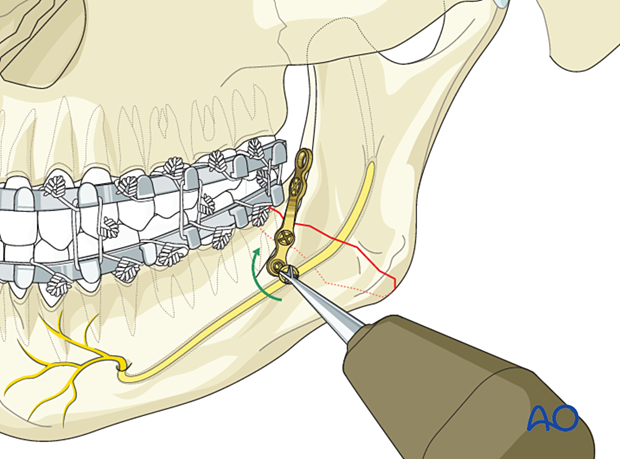
In some cases, the most posterior hole of the plate is accessible for drilling and screw placement whilst the patient is in maxillomandibular fixation.
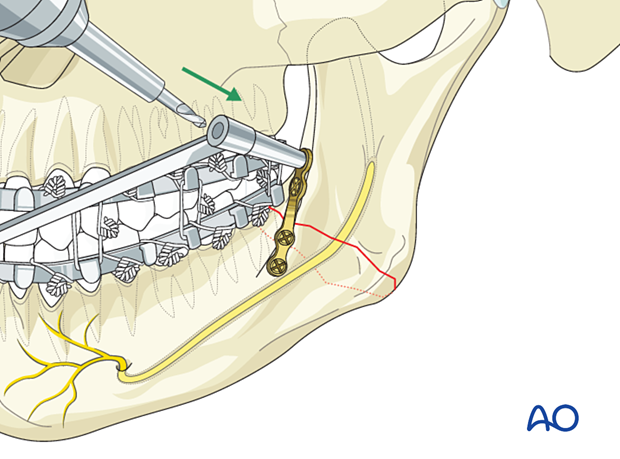
If it is impossible to drill and place the most posterior screw because of inadequate access, the maxillomandibular fixation is released and the mandible can be opened to allow access.
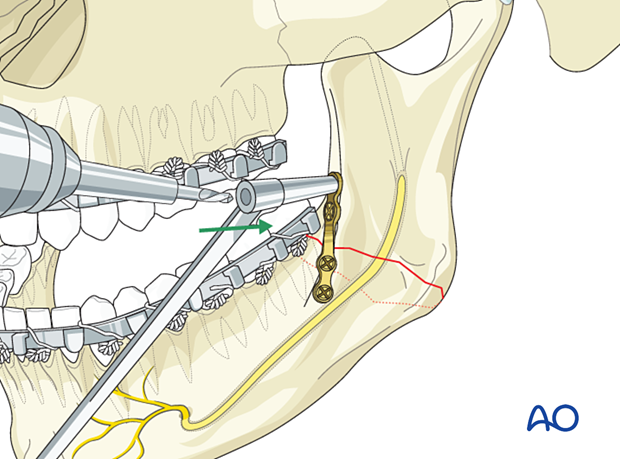
The last screw is inserted and tightened.
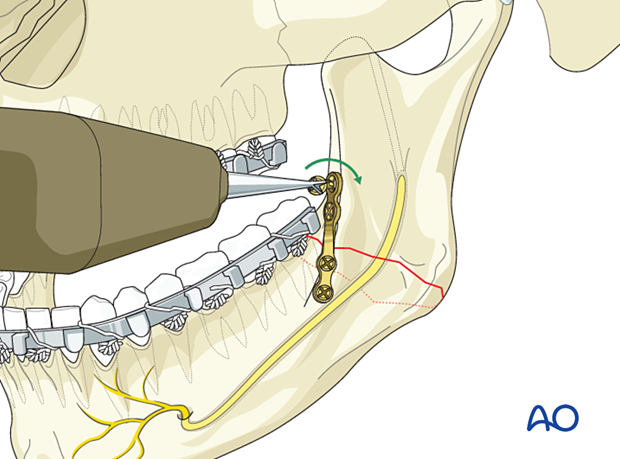
8. Aftercare following ORIF of mandibular symphysis, body, angle, and ramus fractures
Use of jaw bra
If significant degloving of the soft tissues of the mandible has occurred, there may be a consideration for using a jaw bra or similar support dressing.
Arch bars
If arch bars or MMF screws are used intraoperatively, they are usually removed at the conclusion of surgery if proper fracture reduction and fixation have been achieved. Arch bars may be maintained postoperatively if functional therapy is required or if required as part of the fixation.
X-Rays
Postoperative x-rays are taken within the first days after surgery. In an uneventful course, follow-up x-rays are taken after 4–6 weeks.
Follow up
The patient is examined approximately 1 week postoperatively and periodically thereafter to assess the stability of the occlusion and to check for infection of the surgical wound. During each visit, the surgeon must evaluate the patient's ability to perform adequate oral hygiene and wound care and provide additional instructions if necessary. Many patients need to be seen regularly for replacement of their intermaxillary elastics and to encourage range of motion in their TMJ in the later course of the treatment.
Follow-up appointments are at the discretion of the surgeon and depend on the stability of the occlusion on the first visit. If a malocclusion is noted and treatable with training elastics, weekly appointments are recommended.
The patient should be warned to continue routine follow up with their dentist. Fractures near the dental roots can often result in delayed loss of tooth viability, requiring periapical films and additional dental procedures.
Malocclusion
If a malocclusion is detected, the surgeon must ascertain its etiology (with appropriate imaging technique). If the malocclusion is secondary to surgical edema or muscle splinting, training elastics may be beneficial. The lightest elastics as possible are used for guidance, because active motion of the mandible is desirable. Patients should be shown how to place and remove the elastics using a hand mirror.
If the malocclusion is secondary to a bony problem due to inadequate reduction or hardware failure or displacement, elastic training will be of no benefit. The patient must return to the operating room for revision surgery.
Basic postoperative instructions
DietDepending upon the stability of the internal fixation, the diet can vary between liquid and semi-liquid to “as tolerated”, at the discretion of the surgeon. Any elastics are removed during eating.
Patients having only extraoral approaches are not compromised in their routine oral hygiene measures and should continue with their daily schedule.
Patients with intraoral wounds must be instructed in appropriate oral hygiene procedures. The presence of the arch-bars and any elastics makes this a more difficult procedure than normal. A soft toothbrush (dipping in warm water makes it softer) should be used to clean the surfaces of the teeth and arch-bars. Any elastics are removed for oral hygiene procedures. Chlorhexidine oral rinses should be prescribed and used at least three times each day to help sanitize the mouth. Chlorohexidine may cause staining of the teeth and should not be used longer than necessary. For larger debris, a 1:1 mixture of hydrogen peroxide (0.25%)/chlorhexidine (0.12%) can be used. The bubbling action of the hydrogen peroxide helps remove debris. A water flosser, providing a water jet, is a very useful tool to help remove debris from the wires. If a this is used, care should be taken not to direct the jet stream directly over intraoral incisions as this may lead to wound dehiscence.
Physiotherapy can be prescribed at the first visit and opening and excursive exercises begun as soon as possible. Goals should be set, and, typically, 40 mm of maximum interincisal jaw opening should be attained by 4 weeks postoperatively. If the patient cannot fully open his mouth, additional passive physical therapy may be required such as Therabite® or tongue-blade training.
